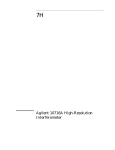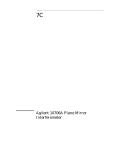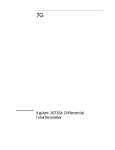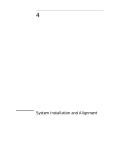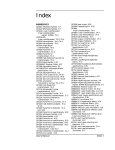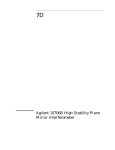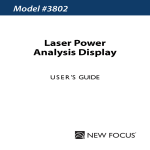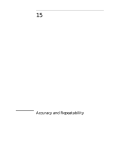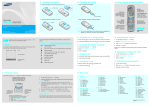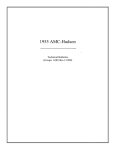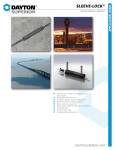Download Chapter 7K Agilent 10721A Two-Axis Differential Interferometer
Transcript
7K Agilent 10721A Two-Axis Differential Interferometer Chapter 7K Agilent 10721A Two-Axis Differential Interferometer Description Description General The Agilent 10721A Two-Axis Differential Interferometer (see Figure 7K-1) is a plane mirror type of interferometer, similar to the Agilent 10719A One-Axis Differential Interferometer (described in subchapter 7J) except that it provides an additional measurement axis. The Agilent 10721A Two-Axis Differential Interferometer is intended for making differential linear and angular measurements, simultaneously, between two separate plane mirrors. The Agilent 10721A interferometer makes two simultaneous adjacent parallel linear measurements, spaced 12.7 mm (0.500 inch) apart. The parallelism between the two measurements is guaranteed by the internal optics and eliminates the parallelism adjustment required when separate linear interferometers are used for measuring angle. An Agilent 10721A interferometer angle measurement is implemented in software via electronic subtraction. The concept of electronic subtraction and a method to calibrate the angle measurement with high accuracy are described in Chapter 4, “System Installation and Alignment,” of this manual. The Agilent 10721A interferometer is designed to use a 3-mm diameter laser beam, available from an Agilent 5517C-003 Laser Head. This beam is smaller than the standard 6 mm beam and allows the measurement plane (center of the beam) to be closer to the upper edge of the X-Y stage measurement mirror, thereby reducing Abbé errors. The Agilent 10721A interferometer’s basic optical resolution is the same as that of the Agilent 10719A and Agilent 10706B interferometers. The Agilent 10721A interferometer’s basic angular resolution is 2.56 arc-seconds, which can be extended electronically by 32X to give 0.08 arc-second resolution. Applications Differential measurements A differential measurement is one in which both the reference beam and the measurement beam travel to external mirrors outside the interferometer housing. This allows measurement of the relative positions of the two external mirrors, either or both of which may move. 7K-2 User’s Manual Chapter 7K Agilent 10721A Two-Axis Differential Interferometer Description REAR VIEW FRONT VIEW Agilent 10721A Two-Axis Differential Interferometer Figure 7K-1. Agilent 10721A Two-Axis Differential Interferometer One useful example of a differential measurement application is in lithography where the motion of an X-Y stage is measured relative to its related optical column. An example of a laser measurement system for this application, including both Agilent 10721A and Agilent 10719A interferometers, is presented in the Agilent 10719A subchapter (subchapter 7J) of this manual. Angular measurements Because the Agilent 10721A interferometer combines the capabilities of two discrete linear interferometers into a single package, it can be used to make angular measurements. For angular measurements, the Agilent 10721A interferometer makes two linear measurements (Y and Y’) with built-in parallelism, spaced 12.7 mm (0.5 inch) apart. The angular measurement is calculated by taking the arctangent of the difference between these linear measurements divided by their separation: Y – Y’ THETA = arc tan -------------D User’s Manual 7K-3 Chapter 7K Agilent 10721A Two-Axis Differential Interferometer Description For more information about angular measurements, see the “Electronic Yaw Calculation Method” and “Optical Yaw Calculation Method” subsections under the “Three-Axis System Using Discrete Plane Mirror Interferometers (X, Y, YAW)” section in Chapter 3, “System Design Considerations,” of this manual. Measurements possible using the Agilent 10721A interferometer are illustrated in Figure 7K-2. A W Y A W LINEAR/ANGULAR MEASUREMENT WITH AGILENT 10721A Y LIN EA R LIN EA R PIT CH REAR VIEW Figure 7K-2. Agilent 10721A Two-Axis Differential Interferometer — measurements Multiaxis configurations Refer to the “Multiaxis Configurations” subsection in the Agilent 10719A subchapter (subchapter 7J) of this manual. 7K-4 User’s Manual Chapter 7K Agilent 10721A Two-Axis Differential Interferometer Description Optical schematic Figure 7K-3 shows the optical schematic of the Agilent 10721A Two-Axis Differential Interferometer. After entering the input aperture, the laser beam is split into two parallel beams, 12.7 mm (0.500 inch) apart. Each of these beams is then split into its separate reference and measurement components. Each of the two measurement beam continues straight through the interferometer to its measurement aperture. Each reference path includes two 90-degree bends, causing that reference beam to be parallel to its related measurement beam, but offset from it by 19.05 mm (0.750 inch). To reduce thermal drift errors, the measurement and related reference beam paths have the same optical path length in glass. This reduces measurement errors due to temperature changes in the interferometer. User’s Manual 7K-5 Chapter 7K Agilent 10721A Two-Axis Differential Interferometer Description λ/4 Plate Reference Mirror REFERENCE PATH (fA) fA(X1) Agilent 10721A Two-Axis Differential Interferometer fA(X2) To Receiver From Laser fA fA(X1) fA(X1) fA(X2) To Receiver Beam Divider Stage Mirror fA(X2) fA(X1) fA(X2) λ4 Plate λ/4 Plate MEASUREMENT PATH (fB) Reference Mirror Agilent 10721A Two-Axis Differential Interferometer To Receiver From Laser fB(X1)±2∆f fB(X1) fB(X1) fB To Receiver Beam Divider fB(X2) fB(X2) fB(X2)±2∆f fB(X1) fB(X2) Stage Mirror λ/4 Plate λ/4 Plate Reference Mirror COMPOSITE (fA and fB) fA(X1) Agilent 10721A Two-Axis Differential Interferometer fA(X2) fA(X1), fB(X1)±2∆f To Receiver fA and fB From Laser Beam Divider To Receiver fA(X2), fB(X2)±2∆f fB(X1) fB(X2) fA(X2), fB(X2) fA(X1), fB(X1) Stage Mirror λ/4 Plate LEGEND = fA = = fB = fA and fB Rounded corners are used to help you trace paths. Figure 7K-3. Agilent 10721A Two-Axis Differential Interferometer — laser beam path 7K-6 User’s Manual Chapter 7K Agilent 10721A Two-Axis Differential Interferometer Special Considerations Special Considerations Laser beam power consideration When you are working with an application that has more than one measurement axis, make sure that you provide enough laser beam power to the Agilent 10721A so it can drive both receivers connected to it. The method for calculating this is described under the “Beam Path Loss Computation” section in Chapter 3, “System Design Considerations,” of this manual. In addition, you should try to balance the available net power (after all losses have been computed), so all receivers in the application will receive nearly equal power. For example, in an application using both an Agilent 10719A interferometer and an Agilent 10721A interferometer, use a 33% beam splitter to send one third of the laser power to the Agilent 10719A interferometer (which has one receiver) and two thirds of the laser power to the Agilent 10721A interferometer (which has two receivers). Configuration and beam locations The Agilent 10721A interferometer is designed to be used in a “straight-through” configuration only. Its input face and measurement face are parallel to each other, on opposite sides of the housing. The locations of the reference and measurement beams, with inputs and outputs identified, are shown in Figure 7K-4. Beam diameter The Agilent 10721A interferometer is similar to other plane mirror interferometers except that its reference paths are redirected to be parallel to their related measurement paths outside the interferometer. Thus, each reference path also requires a plane mirror for its reflector. Receiver considerations The Agilent 10721A interferometer requires the 3 mm diameter beam, available from an Agilent 5517C-003 Laser Head. The smaller diameter beam enables the beam positions on the stage mirror to be closer to the lithographic image plane, reducing Abbé offset errors. User’s Manual 7K-7 Chapter 7K Agilent 10721A Two-Axis Differential Interferometer Special Considerations BEAM LOCATION FOR AGILENT 10721A Sensor Heads for Remote Receivers 31.75 ((1.250)) 19.05 (0.750) Top Four Beams are Reference Beams Input Beam to Interferometer Bottom Four Beams are Measurement Beams 31.75 ((1.250)) FRONT VIEW REAR VIEW Figure 7K-4. Agilent 10721A Two-Axis Differential Interferometer Reference and Measurement beams The Agilent 10721A interferometer is designed primarily for use with the Agilent 10780F Remote Receiver; however, any other Agilent receiver may be used. One receiver is required for each Agilent 10721A output to be used. The advantage of using the remote receiver is that the fiber-optic sensor head can be directly attached to the interferometer, eliminating the need for separate mounting brackets. When laying out an application, be sure to allow enough clearance for the fiber-optic cable without bending it tighter than its minimum bend radius of 35 mm (1.4 inches). Also avoid any kinking where the fiber connects to the sensor head. Kinking or excessive bending of this cable can cause signal attenuation. 7K-8 User’s Manual Chapter 7K Agilent 10721A Two-Axis Differential Interferometer Special Considerations Mounting pins on the interferometer eliminate the need for any user alignment of the sensor head. With the Agilent 10721A interferometer, the receiver’s sensor head can be oriented only one way at each interferometer output aperture, as determined by the location of the threaded mounting hole. Use 4-40×1-inch screws to fasten the sensor heads to the interferometer. Spacing to beam-directing optic The recommended minimum spacing between the interferometer and its beam-directing optic is 63.5 mm (2.50 inches). This spacing will provide the minimum clearance for the fiber-optic cable when the Agilent 10780F Remote Receiver is used. Input and output apertures The Agilent 10721A interferometer has three apertures, which are not interchangeable. The middle aperture must be used for the input beam. The outer two apertures are for the output beams. Both output apertures are equipped with mounting pins for the Agilent 10780F fiber-optic sensor head; therefore, either aperture can be used for the output beam. Direction sense The Agilent 10721A interferometer direction sense depends fundamentally on which laser frequency is in its measurement path. This is affected by on the mounting orientations of both the interferometer and the laser head. In most cases, the Agilent 10721A interferometer will be oriented “upright”, that is, with its top and bottom mounting surfaces horizontal. In this orientation, the internal polarizing beam splitter will send the vertical polarization into the measurement beam path and the horizontal polarization into the reference beam path. As mentioned in Chapter 5, “Laser Heads,” of this manual, the Agilent 5517C-003 Laser Head produces f1 (its lower frequency) with horizontal polarization and f2 (its higher frequency) with vertical polarization. Thus, an Agilent 5517C-003 with its mounting plane horizontal will direct fl into the reference path and f2 into the measurement path. This configuration will result in the fringe counts DECREASING when the measurement mirror moves AWAY from the interferometer. User’s Manual 7K-9 Chapter 7K Agilent 10721A Two-Axis Differential Interferometer Special Considerations The direction sense will change sign for any configuration which rotates either the laser head or the interferometer by 90 degrees. The configuration of the beam-directing optics between the laser head and the interferometer may effectively rotate the laser beam, changing which laser frequency (polarization) is in which interferometer path, and thus the direction sense of the interferometer. Deadpath For the Agilent 10721A interferometer, “zero-deadpath”, the condition in which the measurement beam path length and the reference beam path length are equal, does not occur when the reference and measurement mirrors are coplanar. Because the reference beam travels 19.05 mm (0.750 inch) further through air inside the interferometer than the measurement beam does, the zero-deadpath condition for the Agilent 10721A interferometer occurs when the measurement mirror is 19.05 mm (0.750 inch) farther from the interferometer housing than the reference mirror is. The consequences of this are discussed in more detail under the “Operation” section, later in this subchapter. Reference and measurement mirror requirements A key feature of the Agilent 10721A interferometer is its ability to make relative measurements between a measurement plane mirror and a reference plane mirror. Since mirror size requirements depend on the application, both plane mirrors must be supplied by the user. Recommended optical specifications for these reflectors can be found in the “Specifications and Characteristics” section at the end of this subchapter. You must also provide the mounting system for the mirrors. An important consideration in designing the mountings is to provide the means to ensure that the two mirrors are aligned substantially parallel to each other during system reset (even though they are not, in general, coplanar). Initial parallelism at reset is important for keeping the permitted measurement mirror angle range symmetrical about the initial “zero angle” position. For example, a parallelism error of 10 seconds during reset will effectively reduce the angle range in one direction by 10 seconds and increase it in the other direction by the same amount. 7K-10 User’s Manual Chapter 7K Agilent 10721A Two-Axis Differential Interferometer Mounting The general solution is to provide a way to adjust at least one, and possibly both, mirrors. As explained below, the alignment procedure requires that the reference and measurement mirrors both be made initially perpendicular to the input laser beam. Thus, with three items to adjust (two mirrors and one input beam), at least two of them should be adjustable. The input beam itself usually allows the first adjustment; therefore, one of the two mirrors must provide the second. In a typical lithography application, the reference mirror will usually be stationary (that is, mounted to the optical column), so it is often the convenient choice for attaching to an adjustable mount. Whether mounted with adjustment capability or not, the mirrors must be held rigidly and stably once they are installed. Choose your mounting method should with care, to avoid introducing mounting stresses which deform the mirrors’ surface flatness. Adhesives can be used successfully, but beware of any stress which may be introduced during curing. Your mounting method should also minimize thermal expansion effects which could displace the mirrors and give “false” displacement or rotation measurements. Many methods exist for mounting optics with low stress and high thermal stability. For additional information, a useful introductory article is “The Optic As A Free Body”, Photonics Spectra, Aug. 1985, pp. 49-59. Also, textbooks on opto-mechanical design can provide more information. Mounting Vibration isolation Agilent 10721A interferometers are inherently less susceptible to vibration effects than some other interferometers. The stability of these interferometers is due to the fact that both their reference beams and their measurement beams travel to external mirrors. Any motion of the interferometer itself that is common to both beams will not appear as a measurement. Of course, any vibration between the reference and measurement mirrors will constitute real, measurable, displacements. Interferometer mounting system (user-supplied) Since the mounting system requirements depend on the application, the mounting system must be designed and provided by the user. The following paragraphs provide some guidelines and recommendations for designing the mounting system. User’s Manual 7K-11 Chapter 7K Agilent 10721A Two-Axis Differential Interferometer Mounting The Agilent 10721A interferometer is designed for easy mounting and alignment. It may be mounted in any orientation, using the mounting hole patterns on either the top or bottom surfaces of the housing. The mounting screw thread is 6-32. A key feature of the Agilent 10721A interferometer is that it is designed as a “referenced” interferometer. In other words, the relationships of its internal optical components and laser beam paths to reference surfaces on its housing is specified. This opens the possibility of a mounting scheme which eliminates the need for aligning or adjusting the interferometer. Designing the mounting system The first step in designing the mounting scheme is to determine the nominal position of each interferometer. This is generally dictated by the intended location of the measurement beams on the measurement mirror. The mounting system for each interferometer should be designed to restrict each of the six-degrees-of-freedom (three translational, three rotational). The recommended positional tolerances for mounting the interferometers are given below. Consider an ideal case in which the input laser beam is perfectly aligned to its desired axis: 1. There is no recommended tolerance for locating the Agilent 10721A interferometer along the X-axis since this has no influence on the measurement. 2. The recommended tolerances for locating the interferometer along the Y-axis and Z-axis are ±0.15 mm (±0.006 inch). Positional errors here will displace the effective measurement points on the mirrors by an equal amount. Also, mislocation can offset the beam centering in the input and output apertures. 3. The recommended tolerances for pitch, roll, and yaw of the interferometers are ±15 arc-minutes, relative to the input beam. Here again, mislocation chiefly affects beam centering (though gross errors in roll—that is, over ±1 degree—can start to induce non-linearity error due to polarization misalignment.) The primary reason for these tolerances is to control the measurement points on the mirrors and to ensure that the laser beams will reach the receivers properly aligned, with no clipping or signal loss. Small positional errors do not impair the measurement accuracy, provided they are fixed and do not change during the measurement. 7K-12 User’s Manual Chapter 7K Agilent 10721A Two-Axis Differential Interferometer Mounting With these positional accuracy goals in mind, there are two recommended approaches to designing the mounting system: • Create an accurate, fixed mounting platform which predetermines the location of each interferometer using reference surfaces; or, • Create an adjustable mount with adjustments to “dial in” the positional accuracy after each interferometer is installed. Fixed Mounting Platform: If you use the first approach, the best design for a mounting platform is to make it kinematic. Kinematic means that all 6 degrees of freedom are singly and unambiguously restricted. It is best to use a locating plane, a locating line, and a locating point. The locating plane will be the surface to which the top or the bottom of the interferometer is bolted. The locating line should be a 2-point contact (or rail) which aligns the front face of the interferometer. The locating point should be a 1-point contact (or pad) which constrains side-to-side translations of the interferometer. To install the interferometer, it should be firmly pressed against its locating plane, line, and point while the mounting screws are torqued down. If the platform is made with the above-mentioned accuracy, this mounting method can completely eliminate the need to adjust or align the interferometers during installation. Then only the laser beam itself will need to be aligned to its proper position. Adjustable Mount: The “adjustable mount” approach is recommended when the mechanical tolerances within the application do not permit the use of a pre-determined (non-adjustable) platform. Coarse adjustments may be provided in a variety of ways, such as using slotted holes for the mounting screws. For fine adjustments, micro-positioning stages are available from a variety of vendors. When using adjustable mounts, a key consideration is to ensure that the adjustment capability does not introduce creep or instability into the mounting system. In some applications, a combined approach may be best. For example, perhaps a platform having an accurate, fixed height can be used in conjunction with an adjustment for yaw and side-to-side motion. Whatever approach is used, the interferometer should always be held rigidly and stably once installed. User’s Manual 7K-13 Chapter 7K Agilent 10721A Two-Axis Differential Interferometer Installation Installation Pre-installation checklist In addition to reading chapters 2 through 4, and Chapter 15, “Accuracy and Repeatability,” complete the following items before installing a laser positioning system into any application. Complete Beam Path Loss Calculation (see “Calculation of signal loss” in Chapter 3, “System Design Considerations,” of this manual). Supply plane mirror reflectors. See Chapter 15, “Accuracy and Repeatability,” or “Specifications and Characteristics” section at the end of this subchapter for mirror specifications. Determine the direction sense for each axis, based on the orientation of the laser head, beam-directing optic, and interferometer. Enter the direction sense for each axis into the measurement system electronics. (See Chapter 5, “Laser Heads,” Chapter 14, “Principles of Operation,” and Chapter 15, “Accuracy and Repeatability,” in this manual. Supply suitable mounting means for all components of the laser measurement system, based on the recommendations given earlier in this subchapter and elsewhere in this manual. Provide for aligning the optics, laser head, and receiver(s) on the machine. Be sure to allow for transmitted beam offset of beam splitters (Agilent 10700A and Agilent 10701A) in your design. (See the offset specifications under the “Specifications and Characteristics” section at the end of this subchapter.) Receivers 1. Agilent 10780F, E1708A, or E1709A receiver’s fiber-optic sensor heads may be mounted directly to the Agilent 10719A interferometer’s output aperture. Alignment pins are provided for easy installation and alignment. This eliminates the need for any other user-supplied mount for the sensor head. 2. Maintain a bend radius not less than 35 mm (1.4 inches) to prevent signal attenuation in the Agilent 10780F, E1708A, or E1709A receiver’s fiber-optic cable. 7K-14 User’s Manual Chapter 7K Agilent 10721A Two-Axis Differential Interferometer Alignment Alignment Alignment aid To help in aligning the Agilent 10721A interferometer, an alignment aid (Agilent Part Number 10706-60202) is provided with it. Alignment procedure The objectives of the alignment procedure are: 1. to position the measurement point accurately on the measurement mirror, 2. to minimize cosine error, 3. to maximize signal strength at the receiver, and 4. to ensure a symmetrical range of rotation about the “zero angle” point. To accomplish these goals: 1. the measurement mirror must be aligned perpendicular to its axis of linear motion, and 2. the reference mirror be aligned parallel to the measurement mirror, before the following steps. For a system having more than one measurement axis, choose a practical sequence in which to align the axes before beginning the interferometer alignment. Be aware that the laser head and certain beam-directing optics may be adjusted for the first axis but then will not be permitted to move while aligning subsequent axes. (In fact, the convenience of independent adjustments may suggest the use of additional beam-directing optics in certain cases.) 1 Begin by installing the laser head and the optics in their desired locations and roughly aligning the laser beam so it is centered on the input aperture of each interferometer. Do not install the receivers yet. 2 If the interferometers are mounted on adjustable mounts, instead of fixed platforms which predetermine their locations, position them to within the translational and rotational tolerances described in the previous “Mounting” section. This determines locations of the measurement points on the mirrors. User’s Manual 7K-15 Chapter 7K Agilent 10721A Two-Axis Differential Interferometer Alignment 3 With the interferometers and mirrors properly positioned, finish the alignment by adjusting the input laser beam’s angle and position for each interferometer individually: a. Adjust the angle of the input beam first, using the autoreflection technique. 1 Start by selecting the small aperture on the front turret of the laser head. 2 Insert the alignment aid (Agilent Part Number 10706-60202) into the measurement beam between the interferometer and the measurement mirror. (This may be held in position temporarily by affixing a piece of tape to its yellow label.) This will cause the beam reflecting off the mirror to reflect back out through the input aperture toward the laser head. 3 Angularly adjust the input beam using the beam directing optics or the laser head or both until the reflected beam re-enters the small aperture of the laser head. NOTE Careful, accurate autoreflection at this step is essential to minimizing cosine errors, assuming the mirror is perpendicular to the linear axis of travel. b. Adjust the centering of the input beam on the input aperture second, by visual alignment. 1 Start by switching back to the large aperture on the turret of the laser head (because the small aperture is only roughly aligned to the beam center). 2 Place a piece of translucent tape across the input aperture of the interferometer to make the input beam easily visible. 3 Translate the beam directing optics or the laser head or both to center the input beam on the aperture. Do not disturb the angular alignments already made. With care, you can center the beam visually to within ±0.15 mm (±0.006 inch) of its ideal position. c. Go back to steps 3a and 3b and alternately recheck and readjust the input beam angle and centering until both are simultaneously optimized. Then remove the tape from the input aperture and remove the alignment aid. d. As a further alignment check, place a piece of translucent tape across the output aperture(s) to make the output beam(s) easily visible. Each output beam should now be approximately centered in its aperture without clipping. NOTE Any clipping observed here indicates a centering problem at the input aperture or an autoreflection problem. 7K-16 User’s Manual Chapter 7K Agilent 10721A Two-Axis Differential Interferometer Alignment e. Clamp down the laser and the beam directing optics without altering their alignment. 4 At this point, the reference beam has also been automatically aligned, assuming the reference mirror is parallel to the measurement mirror. If any parallelism error exists, then the beam overlap in the output aperture(s) will be degraded, and this may be visible. Beam overlap can be checked qualitatively by alternately blocking the reference and measurement beams and observing their respective positions on the tape across the output aperture(s). Remove tape when done. NOTE If a beam overlap problem exists, recheck the parallelism of the reference mirror, relative to the measurement mirror. Adjust as needed. 5 Attach the fiber-optic sensor heads using 4-40 screws. 6 Repeat the above steps for all other interferometers in the application, being careful to adjust only beam-directing optics which do not disturb the alignments already completed. User’s Manual 7K-17 Chapter 7K Agilent 10721A Two-Axis Differential Interferometer Operation Operation Reset considerations If the reflectors you use with the interferometer are not at their zero-deadpath positions when you reset the system, you should enter a zero-deadpath compensation value, as described under “Deadpath Compensation Considerations”, below. Deadpath compensation considerations Proper use of deadpath compensation is essential to achieving maximum accuracy. For the Agilent 10721A interferometer, “zero-deadpath”, the condition in which the measurement beam path length and the reference beam path length are equal, does not occur when the reference and measurement mirrors are coplanar. Because the reference beam travels 19.05 mm (0.750 inch) further through air inside the interferometer than the measurement beam does, the zero-deadpath condition for the Agilent 10721A interferometer occurs when the measurement is 19.05 mm (0.750 inch) farther from the interferometer housing than the reference mirror is. Deadpath compensation for the Agilent 10721A interferometer can be performed in one of two ways: • move the measurement mirror to the zero-deadpath position before each system reset, or • use a deadpath compensation number in software. If you use this method, be aware that the compensation number can be either positive or negative, depending on the relative position of the mirrors at reset. 7K-18 User’s Manual Chapter 7K Agilent 10721A Two-Axis Differential Interferometer Specifications and Characteristics Specifications and Characteristics Agilent 10721A Two-Axis Differential Interferometer Specifications USE: Multiple-axis applications such as precise positioning of a multiaxis stage, where the stage must be linearly and angularly positioned with respect to an external object such as a column or inspection tool. The interferometer can be made vacuum compatible. Parallelism (Input to output beams): <0.1 mrad (20 arc-sec) SPECIFICATIONS Operating Temperature: 17 to 23°C INSTALLATION RECOMMENDATIONS Optical Efficiency (output beam/input beam): Average: 27% Worst Case: 18% Installation and alignment: Kinematic installation requires a referenced surface. Weight: 300 grams (11 ounces) Dimensions: see Figure 7K-5 on the next page Inter-axis Alignment: All internal optics are reference to mounting surface and have fixed alignment. Materials Used: Receivers: Agilent 10780F fiber-optic remote receivers or Housing: Aluminum Optics: Optical grade glass Adhesives: Vaccum grade Agilent 10780C receivers. Receiver Alignment: Self-aligning when mounted to interferometer. Axis: Linear and yaw MEASUREMENT AND REFERENCE (PLANE) MIRROR Available Beam Size: 3 mm RECOMMENDATIONS Thermal Drift Coefficient (Average): 150 nm (5.9 µin.)/°C Reflectance: 98% at 633 nm, normal incidence. Resolution:* Flatness: Depending on accuracy requirements of the application, mirror flatness may range from λ /4 to λ /20 (0.16 to 0.03 µmeters, 6 to 1.2 µinches). Optical: λ /4 Linear: 5 nm (using 32 × resolution extension) 0.62 nm (using 256 × resolution extension) Optical Surface Quality: 60—40 per Mil-0-13830. Angular (pitch or roll): 0.7 µrad (0.14 arc-sec)-using X32 electronics 0.1 µrad (0.02 arc-sec)-using X256 electronics Range:** NOTE: Flatness deviations will appear as measurement errors when the mirror is translated across the beam. Mirror mount should be kinematic so as not to bend mirror. If accuracy requirements demand it, mirror flatness might be calibrated (scanned and stored in the system controller) to be used as a correction factor. Linear: 10m (33 ft) Angular (yaw): at distance = 150 mm at distance = 300 mm ± 0.88 mrad (± 3 arc-min) ± 0.44 mrad (± 1.5 arc-min) *Linear and angular resolutions are dependent on the electronics used. Optical resolution is dependent only on the interferometer, and can be used to determine linear and angular resolutions when the electronic resolution extension is known. The linear and angular specifications in this section are for interferometer use with the X32 resolution extension electronics (10885A, 10895A) or X256 resolution extension electronics (10897B, 10898A). ** Linear range here is the sum of the ranges for all axes. Angular range is the maximum measurement mirror angle due to all components (i.e. , yaw and pitch, or yaw and roll) between the measurement mirror and the interferometer for a 6-axis system. Range will be reduced when the reference mirror is misaligned. User’s Manual 7K-19 Chapter 7K Agilent 10721A Two-Axis Differential Interferometer Specifications and Characteristics 63.5 mm (2.500) Recommended Minimum 35.56 mm (R1.400) Fiber Optic 10707A BEAM BENDER To Mirrors Fiber Optic 35.56 mm (R1.400) Minimum 43.18 mm (1.70) 9.12 mm (0.359) 28.98 mm (1.141) 19.05 mm (0.750) 9.12 mm (0.359) 57.15 mm (2.250) 19.86 mm (0.782) 7.16 mm (0.282) 7.16 mm (0.282) Ref 60.33 mm (2.375) Four be ams t o reference mirror 19.05 mm m (0.750) Four be ams t o measurement mirror Meas 31.75 mm (1.250) 31.75 mm (1.250) 10721A put Aperture for 3 mm input be am Output Aperture #2 3.18 mm (0.125) 12.70 mm (0.500) spacing bet ween 12.70 mm linear measurements (0.500) FRONT VIEW REAR VIEW TWO-AXIS DI FF D E I N U .S . A ENTIAL IN ER MA . SERIAL NO. 3112A Fiber Optic sensor head mounting pi ns 31.75 mm (1.250) 38.10 mm (1.500) TER OM Output rture #1 Four mounting holes on t op and b ottom surfaces. (6-32) 8.0 mm (0.31) deep 31.75 mm (1.250) 9.53 mm (0.375) Figure 7K-5. Agilent 10721A Two-Axis Differential Interferometer — Product specifications and descriptions in this dimensions document subject to change without notice. Copyright (C) 2002 Agilent Technologies Printed in U.S.A. 07/02 This is a chapter from the manual titled: Laser and Optics User's Manual For complete manual, order: Paper version: p/n 05517-90045 CD version: p/n 05517-90063 This chapter is p/n 05517-90118 7K-20 User’s Manual






















